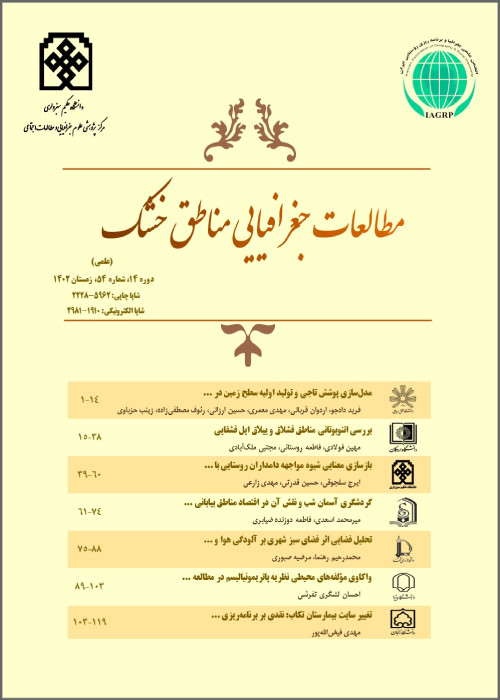Examining the Relationship between Spatial Structure and Regional Disparities in the Provinces of Iran
Author(s):
Abstract:
Introduction
Assumptions about relationship between spatial structure and regional disparities reduction once has attracted the attention of policy makers and scholars alongside with the introduction of polycentric development policies in Europe and national level during the recent decades. Accordingly the present article attempted by examining the economic and experimental test of such assumptions in the country to establish a foundation for supporting the polycentric development policies. In this regard a review on economic growth models show that these theories paid a little heed to the development of city structure and the role which it can play in the reduction of regional disparities. So, there is a weak theoretical base of relations between regional economic growth, polycentric and disparities as assumed by many policies. This study tried to find out an experimental basis for this relation. The main question is that whether a polycentric urban structure is really effective on the reduction of regional disparities?Research
Methodology
The present research is applied by aim and regarding to its nature and procedure include a correctional study. In this regard, to answer the main question of the study; in first step the different provinces of country are measured for their level of polycentricism. Then by using the secondary data of regional disparities of each province extracted from statistical records from Statistical Center of Iran; the correlation between two components were determined using Pearson method. For more detail analysis; firstly the correlation among the components, polycentric indicators and regional disparities were illustrated in 2012 and in next stage such correlation between components and polycentric indexes and the level of variations of each regional disparity index was shown in 2005 and 2012. In this study, the primate city index, focal analyses were applied for measuring the dimensions of polycentricism. Also, Gini coefficient, dispersion index and the poor's share of consumption were used to show the disparity.Results and Findings: The results from 31 provinces of the country showed no evidences regarding to the association between the spatial dispersion of cities or balanced distribution of centers and in general polycentric/mono-centric can reduce disparities in the region. So that all obtained figures were less than 0.35. This means that correlation coefficient among the variables explained even less than 0.4 percent of their variations. Also the direction of correlation supported mono-centric urban systems. Other variables illustrated even lesser associations such as coefficient of correlations for polycentric/mono-centric development, the variation of Gini coefficient, dispersion index and the share of consumptions of poor. These findings confirmed the results of Sandberg and Meijers (2008) which showed weak connection between polycentric development and regional disparity in European countries. But in the present research there was a weak indirect correlation between polycentric and regional disparity. However these findings showed a less direct significant link of spatial structure on the trend of reduction of spatial disparities; however it supported the polycentric system slightly. While the results of Sandberg and Meijers indicated the positive role of mono-centric system on the reduction of regional disparities. Also assessment of relationship between regional disparity and the most polycentric and mono-centric of different provinces indicated an important point. So that this not only showed the significant and considerable correlation (0.546) between two components but it supported the polycentric structures strongly. While the correlation of disparities and distribution of center size increased the figure to 0.7.
Conclusion
It now can be concluded that at least in the case of Iran; contrary to some assumptions under influence of early intervention and current technological and structural changes; it does not confirm that the concept of inequality and periphery will become more spatial issue. So there is a need of deeper knowledge to theoretical and its backup like regionalism to adopt "polycentric development". From this perspective, further attention should be given to institutional approaches and capacity in the analysis of regional issues like disparity. However the results of these studies have not been able to provide empirical justification for the claim that polycentric development can reduce disparity and lead to solidarity; but it can shift the attention of commentators towards theoretical foundations of polycentric development and the change from a descriptive-analytical conception to a normative concept; and from a mere spatial term to a network of cooperation and coordination. So it seems essential other researches to concentrate not only on the economic- geographical aspects but on institutional and its relations with the claims of polycentric development; certainly such studies could help better understanding of development policies for implementation in the country. Keywords:
Language:
Persian
Published:
Arid regions Geographic Studies, Volume:6 Issue: 21, 2015
Pages:
15 to 29
magiran.com/p1526887
دانلود و مطالعه متن این مقاله با یکی از روشهای زیر امکان پذیر است:
اشتراک شخصی
با عضویت و پرداخت آنلاین حق اشتراک یکساله به مبلغ 1,390,000ريال میتوانید 70 عنوان مطلب دانلود کنید!
اشتراک سازمانی
به کتابخانه دانشگاه یا محل کار خود پیشنهاد کنید تا اشتراک سازمانی این پایگاه را برای دسترسی نامحدود همه کاربران به متن مطالب تهیه نمایند!
توجه!
- حق عضویت دریافتی صرف حمایت از نشریات عضو و نگهداری، تکمیل و توسعه مگیران میشود.
- پرداخت حق اشتراک و دانلود مقالات اجازه بازنشر آن در سایر رسانههای چاپی و دیجیتال را به کاربر نمیدهد.
In order to view content subscription is required
Personal subscription
Subscribe magiran.com for 70 € euros via PayPal and download 70 articles during a year.
Organization subscription
Please contact us to subscribe your university or library for unlimited access!



